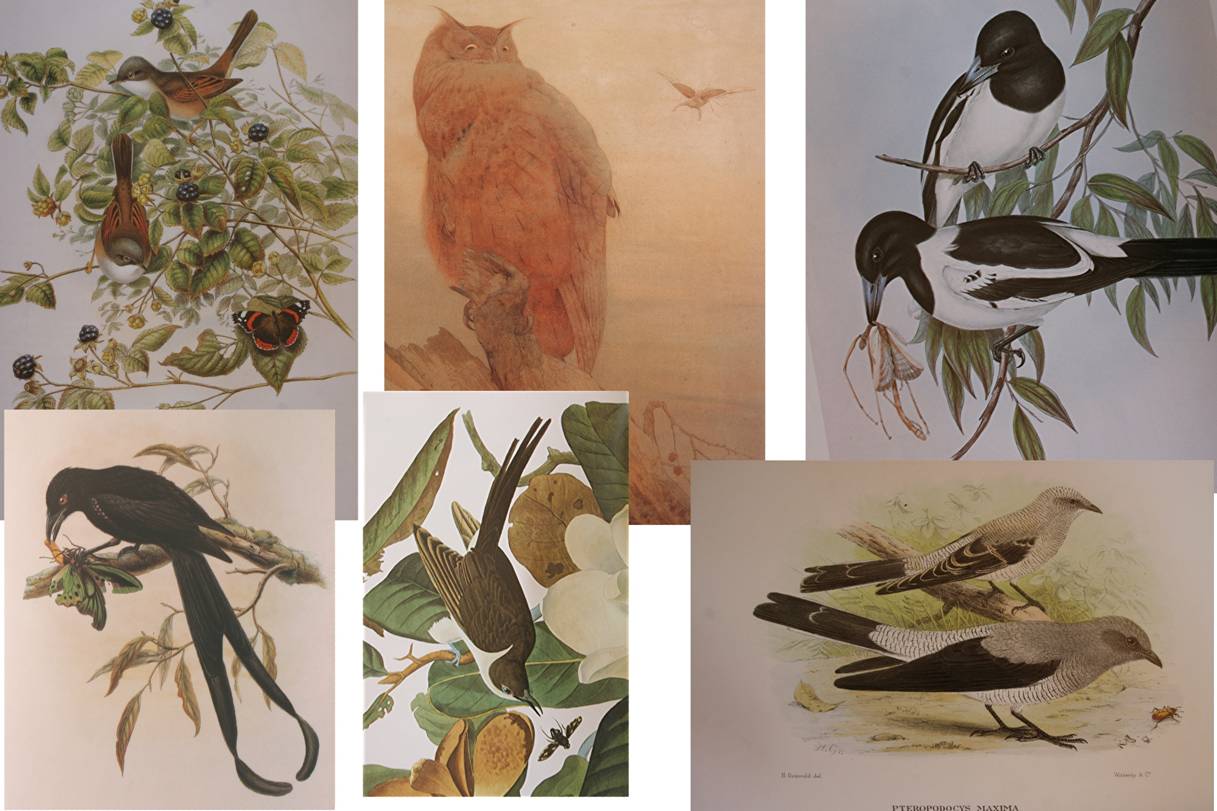I didn’t expect anyone to
get the precise sources. The common element was that all the insects come
from bird illustrations that have been published and republished. Philip
was close in that regard. As I don’t know much about insects myself
I was impressed by Steve Holliday’s typically field-knowledgeable
responses below, verging on the unbelievable.
I won’t recirculate the
original graphic. This is a more informative view of the sources, in a
slightly different order :

For those interested –
Number 1 was the familiar Red
Admiral of the European countryside, sitting on a blackberry leaf in Henry
Richter’s drawing of Whitethroats, in Gould’s ‘Birds of Great
Britain’ .
Number 2 was also from a Richter
drawing, the Pied Butcherbird in Gould’s ‘Birds of
Australia’. About all I can tell you is that it is a stick insect
or ‘phasmid’. Gould probably called for its inclusion,
because he said in the text that ‘ ... large Phasmiae come within
the list of its ordinary diet’.
Number 3 was a flying stag
beetle, being eyed by the improbable Eagle Owl in the painting by Edward
Detmold (1883-1957). Must be some symbolism in there somewhere.
To show how little I know about
insects, I chose number 4 out of a host of insect-adorned paintings in Audubon
reproductions because I thought on a quick look, subject to checking, that the
large dark insect flying up in the tree was a Periodical Cicada, of which the
southern US species emerge each 13 years. In fact it lacks the blunt head
and it has but a single pair of wings, so is a fly. Audubon himself wrote
that the relevant Black-billed Cuckoos (before he shot them, near a swamp in Louisiana)
‘were in pursuit of such flies as you see figured’. But what
kind of fly? Because of the thick black body and patterned wings (more
obvious in the watercolour) I wonder if it could be one of the ‘bee flies’
Anthrax spp. Anyway, that’s my guess. (Both the
genus name and the disease name come from the Greek ‘anthracitos’ –
‘coal’.)
Number 5. William Hart
drew the Ribbon-tailed Drongo for Gould’s ‘Birds of New Guinea’
and included the large butterfly. It is a male of the Ornithoptera
or ‘Birdwing’ group - well done Julian T. This unusual
drongo is endemic to New Ireland in the Bismarck Archipelago so the butterfly
should have been O priamus urvillianus – D’Urville’s
Birdwing. However, from pictures it seems to me that in all variations of
urvillianus the males are, by contrast with other male Ornithoptera, black or
very dark on the upper surface of the wings. It seems likely that Hart
was simply handed any old Ornithoptera from the collection in the British
Museum (Natural History). “They won’t know the difference”,
Gould would have said, as he was getting on a bit, and died before completion
of the project, and none of them had been to New Guinea. As it happens,
the insect is drawn life-size in considerable detail, so an Ornithoptera expert
could probably identify the subspecies (or species) that Hart used as his
model.
Number 6. More than
half of the illustrations for Gregory Mathews’ ‘Birds of Australia’
were prepared by the Danish-born Henrik Gronvold (1858-1940). Many of the
drawings, although set against some kind of background are far from life-like
and have little adornment. An exception is the Ground Cuckoo-shrike
plate, in which, under the critical stare of a GCS, Henrik included a
beetle. As he spent many years in the British Museum (Natural History)
preparing precise illustrations of birds and other animals for scientific
publications, I think it unlikely that he would have just dashed off an
imaginary beetle or used one that does not occur in Australia. He could
easily have sketched something from the museum’s Australian collection. I
am not able to take the identification any further.
From: Steve Holliday
[
Sent: Friday, 6 March 2009 3:11 PM
To: 'Geoffrey Dabb'
Subject: RE: [canberrabirds] Insect ID
Ha, I’ve missed
your quizzes!
1. The Red Admiral of Britain and most of the
rest of the Northern Hemisphere
2. A stick insect in somebody’s beak
3. A male stag beetle
4. An interesting looking true fly (order
Diptera) of some sort or other
5. A male birdwing butterfly with a mystery foot
on it, don’t know which spp, males are mostly green and black, and there
are 3 now recognised in Australia alone, as well as a fair few more from the
islands to our north. One you would remember from your New Guinea days?
6. Another beetle, beyond that I don’t
know. Unless it is Alexander Beetle.
And what do they have
in common? Don’t know. Wings? Something to do with the illustrators?
Would be interested to know the sources of the illustrations.
regards
Steve
From: Geoffrey Dabb [
Sent: Friday, 6 March 2009 2:04 PM
To:
Subject: [canberrabirds] Insect ID
Can you identify these birdwatchers’ insects? Not necessarily Australian. Generic answers
will suffice. What do they have in common?
I correct - Pass
2 correct - Very
good
3 correct - Excellent
4 correct - Unbelievable
5 correct – Uncanny

